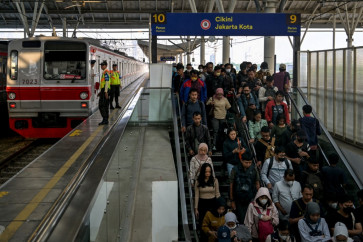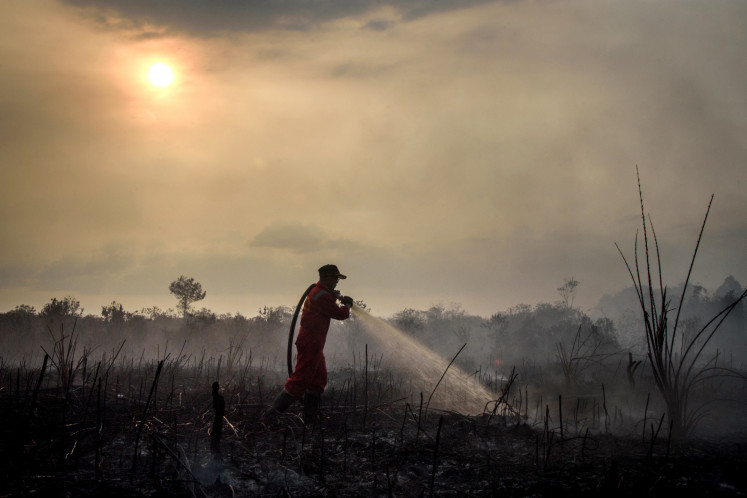Popular Reads
Top Results
Can't find what you're looking for?
View all search resultsPopular Reads
Top Results
Can't find what you're looking for?
View all search resultsClimbing up the global value chain
There has been a paradigm shift in international trade
Change text size
Gift Premium Articles
to Anyone
T
here has been a paradigm shift in international trade. Trade in intermediates (semi-finished products) has overtaken trade in final goods and services as global value chains proliferate.
Advancements in production, information and communication technology, transportation and logistical efficiency, and a general reduction in tariffs, has allowed for production tasks to be performed in multiple countries, giving rise to global value chains. As goods carry multiple origins, gross trade data no longer accurately reflects actual trade between countries.
While countries and firms compete to participate in global value chains, participation in itself does not automatically confer benefits. Rents are quickly eroded by new entrants, and price-driven competition slips easily into a race to the bottom. Strategic participation requires proactive actions, including conscious policy choices.
The Indonesian government launched the Master Plan for Acceleration and Expansion of Indonesia Economic Development (MP3EI) 2011-2025 in May 2011, as it strives to be among the world’s top 10 economies by 2025. Increasing value addition and expanding industrial value chains was identified as a key means to meet the continuous 7-9 percent growth required to achieve this objective. It is recognition that reliance on consumption-driven growth and a few commodity exports is insufficient.
Trade accounted for 56 percent of Indonesia’s gross domestic product (GDP) in 2011. The import content of Indonesia’s exports is 18 percent, lower than China (27), India (19), Thailand (38) and Vietnam (28). While statistics showed that intermediate goods accounted for more than three quarters of Indonesia’s exports, the classification used does not separate raw materials from intermediate goods, where the former could be significant.
The declining share of final goods in Indonesia’s exports reflects the competitiveness of other low-cost economies, such as China and Vietnam, as a base for final assembly. It also reflects Indonesia’s growing domestic consumption and, unfortunately, the declining productivity of its manufacturing sector.
While the bulk of Indonesia’s imports are intermediate goods, the shares of imports for household consumption and mixed-end use have been increasing.
In 2011, domestic consumption accounted for 61 percent of Indonesia’s GDP, or almost double that of its exports. With a growing domestic market and emerging middle class, Indonesia’s interest to promote domestic value addition in exports and domestic consumption — in other words climbing up global value chains — is justified. But what does this mean exactly, and how does one do so?
Climbing up global value chains is often narrowly defined as moving toward downstream processing, but this is an incomplete notion. Values can also be created by broadening the breadth of the chains, creating new ones, and strengthening domestic linkages to existing chains.
High rent activities often lay at both ends of the production process: R&D, branding and design and marketing and distribution respectively. The low-technology parts of the value chains, such as simple processing, often serve as entry points for low-skilled workers and small and medium enterprises. Where economic upgrading does not go in tandem with social upgrading, policy balancing is required.
China’s experience taught us that low-cost manufacturing cannot sustain an economy. Keeping wages as low as possible is not the answer to competitiveness, and a holistic and coherent approach to global value chain participation is imperative. While policy directions have been set in MP3EI, the issue is one of design and execution.
The current focus on connectivity, human resources and national innovation system is a good start. While recent measures involving trade restrictions have been criticized as a return to populist economic nationalism, a complete laissez-faire approach is also not the way to go.
Export and import regulations, guided by clear policy directions and supported by coherent complementary measures, can help build competitiveness in the long-run, but they must not lead to perpetual protection of inefficient industries. Ad hoc use of non-tariff measures without clear policy justification creates uncertainties and is self-defeating. And ballooning fuel subsidies will spiral into bigger problems if left unaddressed.
The private sector should be helped to utilize existing and future market access through rules of origin training, standards compliance and market intelligence. They should be consulted with during trade negotiations and reviews of trade agreements. Relevant authorities dealing with trade facilitation should have the requisite capacity of international best practice.
Indonesia needs a proactive approach to trade in services given that the sector provides key inputs to all value chains, and competitiveness goes a long way. Diversification to non-traditional markets should also be actively pursued. A sound investment framework and well-designed investment incentives should be established and address inconsistencies between national and sectoral, and national and sub-national policies.
Better collaboration between educational and training institutions and the industry should be promoted, as improving labor productivity is imperative. Clear and coherent labor policy and effective law enforcement is needed for labor market stability, while enhancing the quality of Indonesian contract institutions is necessary to move the economy to knowledge-intensive sectors. Lastly, national, sub-national and sectoral innovation systems should be strengthened through stakeholders’ partnership.
This is not easy task and policy space is further limited by existing multilateral, bilateral and plurilateral commitments. As Indonesia chairs Asia-Pasific Economic Cooperation (APEC) this year and hosts the WTO Ministerial Conference later in the year, its mission to enhance benefits from global value chain participation, now a buzz word within the trade community, will be closely watched by other countries.
Can the government successfully intervene to maximize benefits from global value chain participation? Moreover, can it prove that participating in global value chains in a sustainable and development-enhancing ways is possible for developing countries?
The writer is a research associate at the Trade Knowledge Network (TKN) Southeast Asia of the International Institute for Sustainable Development (IISD). This opinion piece is part of study conducted by TKN Southeast Asia, which is available at www.iisd.org/tkn/research/pub.aspx?id=1737










